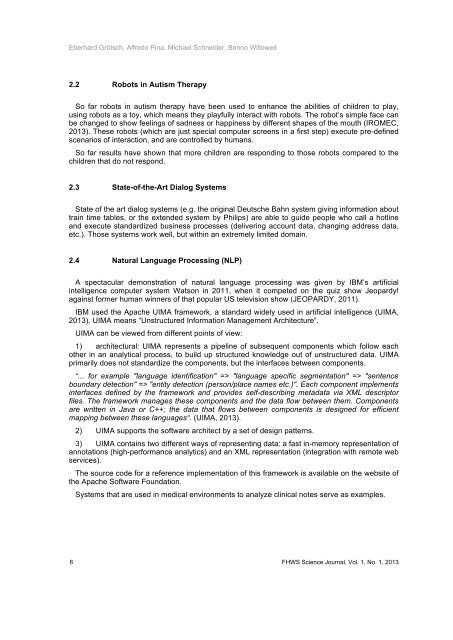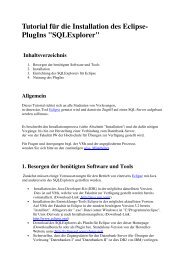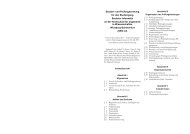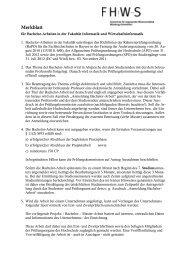FHWS Science Journal - Fakultät Informatik und Wirtschaftsinformatik
FHWS Science Journal - Fakultät Informatik und Wirtschaftsinformatik
FHWS Science Journal - Fakultät Informatik und Wirtschaftsinformatik
Create successful ePaper yourself
Turn your PDF publications into a flip-book with our unique Google optimized e-Paper software.
Eberhard Grötsch, Alfredo Pina, Michael Schneider, Benno Willoweit<br />
2.2 Robots in Autism Therapy<br />
So far robots in autism therapy have been used to enhance the abilities of children to play,<br />
using robots as a toy, which means they playfully interact with robots. The robot’s simple face can<br />
be changed to show feelings of sadness or happiness by different shapes of the mouth (IROMEC,<br />
2013). These robots (which are just special computer screens in a first step) execute pre-defined<br />
scenarios of interaction, and are controlled by humans.<br />
So far results have shown that more children are responding to those robots compared to the<br />
children that do not respond.<br />
2.3 State-of-the-Art Dialog Systems<br />
State of the art dialog systems (e.g. the original Deutsche Bahn system giving information about<br />
train time tables, or the extended system by Philips) are able to guide people who call a hotline<br />
and execute standardized business processes (delivering account data, changing address data,<br />
etc.). Those systems work well, but within an extremely limited domain.<br />
2.4 Natural Language Processing (NLP)<br />
A spectacular demonstration of natural language processing was given by IBM’s artificial<br />
intelligence computer system Watson in 2011, when it competed on the quiz show Jeopardy!<br />
against former human winners of that popular US television show (JEOPARDY, 2011).<br />
IBM used the Apache UIMA framework, a standard widely used in artificial intelligence (UIMA,<br />
2013). UIMA means “Unstructured Information Management Architecture“.<br />
UIMA can be viewed from different points of view:<br />
1) architectural: UIMA represents a pipeline of subsequent components which follow each<br />
other in an analytical process, to build up structured knowledge out of unstructured data. UIMA<br />
primarily does not standardize the components, but the interfaces between components.<br />
“... for example "language identification" => "language specific segmentation" => "sentence<br />
bo<strong>und</strong>ary detection" => "entity detection (person/place names etc.)". Each component implements<br />
interfaces defined by the framework and provides self-describing metadata via XML descriptor<br />
files. The framework manages these components and the data flow between them. Components<br />
are written in Java or C++; the data that flows between components is designed for efficient<br />
mapping between these languages“. (UIMA, 2013).<br />
2) UIMA supports the software architect by a set of design patterns.<br />
3) UIMA contains two different ways of representing data: a fast in-memory representation of<br />
annotations (high-performance analytics) and an XML representation (integration with remote web<br />
services).<br />
The source code for a reference implementation of this framework is available on the website of<br />
the Apache Software Fo<strong>und</strong>ation.<br />
Systems that are used in medical environments to analyze clinical notes serve as examples.<br />
6 <strong>FHWS</strong> <strong>Science</strong> <strong>Journal</strong>, Vol. 1, No. 1, 2013








